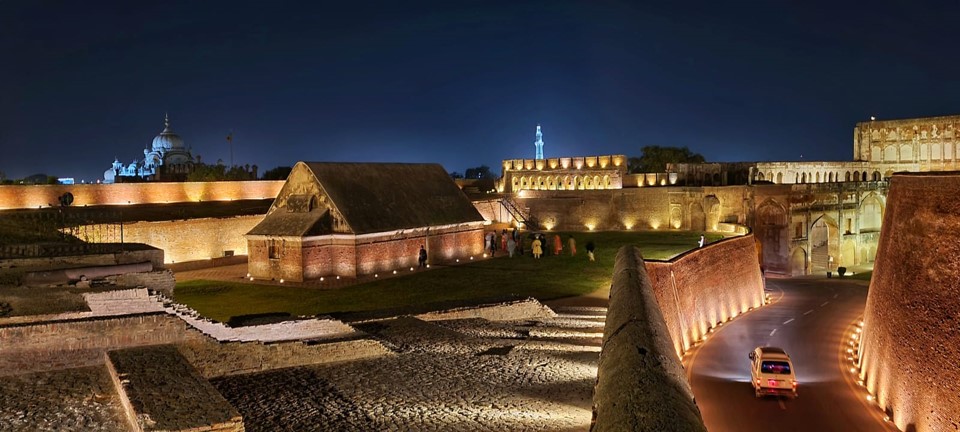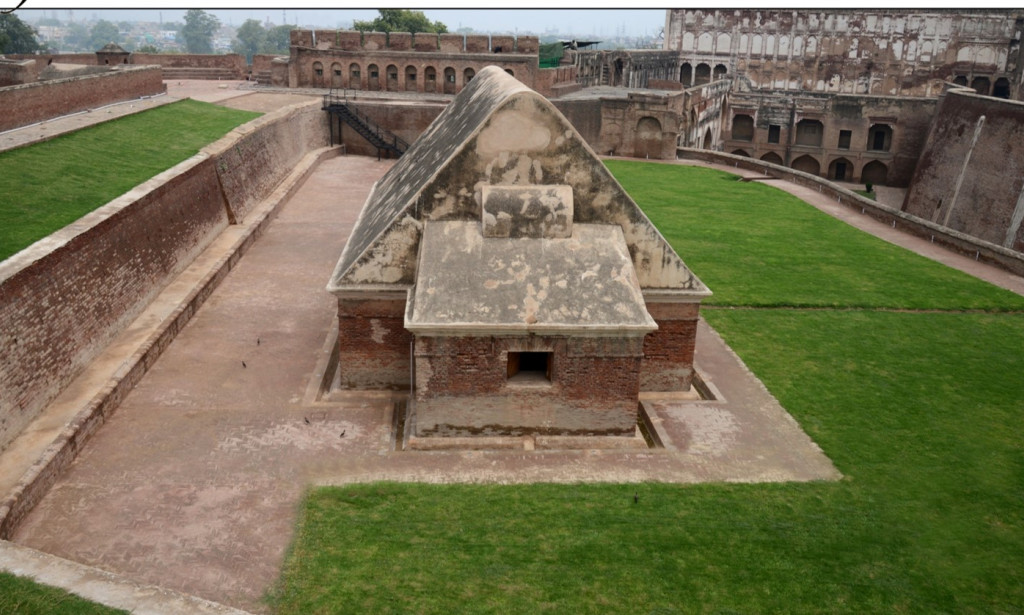As the sun dipped below the horizon, casting a golden glow over the majestic walls of the fort, I embarked on a journey of discovery to unravel the secrets of the elusive Barood Khana. Many among us are still unaware of this gem in Lahore fort. Beyond the well-known palaces and mesmerizing architectures there, lies a secreted gem, shrouded in mystery and intrigue – the massive Barood Khana.

Until 2019, this hidden gem remained obscure, buried beneath layers of debris and overgrown vegetation, its existence unknown to most. A testament to its past, it once safeguarded vast quantities of gunpowder and an array of weaponry, preserving the secrets of its bygone era. Neglected for years, now this piece of the history, has undergone a magnificent restoration. And one can see that the Walled City of Lahore Authority, now the custodians of Lahore Fort, have turned this vanishing structure into a tourist hotspot.

Situated in the southwestern corner of the fort and constructed in 1857, it held a pivotal position within the Lahore Fort. The Barood Khana, stands as a remarkable testament to the era of British rule in this region. In stark contrast to other majestic monuments within the citadel, such as the pristine Pearl Mosque or the ethereal Sheesh Mahal, the Barood Khana reflects a utilitarian purpose embraced by the British.
This Barood Khana also symbolizes the early modern age that was unfolding in the Western world. The spirit of the Renaissance, Reformation, and Scientific Revolution, spanning the 16th to 19th centuries, propelled Western society forward with great leaps in history.
During the turbulent years, particularly during the events of 1857, a defensive mindset prevailed among the British rulers overseeing the mastery of Lahore and fort. This defensive stance necessitated the establishment of military and sentry posts throughout the Lahore Royal Citadel. To sustain and replenish these sentry posts, the construction of the Barood Khana, within the citadel became essential.

During the construction of the building, significant structural alterations were made to Lahore Fort. The British authorities, in their efforts to safeguard the gunpowder magazine, brought about a complete transformation in the southern part of the citadel. The fort, once a splendid Mughal royal residence, was converted into a fortified military stronghold under British rule. Additionally, the British authorities, in line with their military focus, decided to remove the arcade garden that had previously adorned the area where the current tarmac road begins.
Now, let me tell you a little about the structure and architecture. The Barood Khana features a groin vault design both on its exterior and interior. It is said by different analysts and historians that this specially designed chamber served as a storage facility for gunpowder, ensuring controlled temperature conditions by storing the explosive substance in barrels. Nearby, other structures, now in ruins and barely recognizable, were once part of the fort’s landscape. Although they are no longer present, it can be assumed that these remnants were once interconnected with the path leading to the Alamgiri Gate, just like the ones we see near the Shah Burj Gate.
The Barood Khana was conveniently accessible through a well-constructed tarmac road that extended from the Shah Burj gate of the Lahore Fort. According to references and historians, the British introduced motorized carriages, a revolutionary advancement at the time, to transport gunpowder swiftly and efficiently to the various sentry points scattered within the fort.
The Barood Khana played a crucial role as a central storage facility for an abundant supply of gunpowder. This strategic location served as a pivotal point for transporting the gunpowder to various military sentry posts within the fort itself. Additionally, in the latter half of the 19th century, several civilian buildings outside the citadel were repurposed into gunpowder magazines which also include the Barood Khana Haveli and the Mariam Zamani Mosque.
The Barood Khana had remained hidden, buried under a staggering 150,000 cubic feet of debris and overgrown vegetation. Unbeknownst to all, this massive structure lay concealed beneath the accumulated layers. However, one fateful day, the Walled City of Lahore Authority (WCLA) embarked on a mission to clear the debris, unaware of the remarkable discovery that awaited them. As the debris was painstakingly removed, the true nature of the structure was revealed—it was a British arsenal depot. This unexpected revelation sparked a series of investigations and conservation efforts, marking the beginning of a journey to uncover the secrets and restore the historical significance of the Barood Khana.
When Barood Khana emerged from its slumber, the passage of time had etched its mark on the venerable structure. Bulging plaster, crumbling brickwork, weathered cornices, worn wooden doors, and ventilators whispered tales of neglect and abandonment. The once-vibrant surface, was marked with graffiti, bore witness to a forgotten past. Doors and windows, neglected for far too long, showed the scars of age, invaded by termites and woodworms.
Regrettably, the previous conservation efforts for Lahore Fort had overlooked the significance of Barood Khana, resulting in its loss of historic function and a dilution of its architectural appearance.
The Walled City of Lahore Authority embarked on a meticulous restoration quest, a tribute to the architectural heritage of the city. Layers of debris were meticulously peeled away, exposing the hidden marvel beneath. Skilled artisans restored the damaged plaster to its former glory, meticulously recreating the missing brick masonry, and breathing life into the delicate cornices. The weary wooden doors and ventilators, symbols of a bygone era, were tenderly revived, their faded splendor rekindled.
The meticulous conservation efforts for Barood Khana began with the arduous task of clearing away dense vegetation and debris. The clearing process itself took nearly a month. In later stages, documentation of the monument through 3D laser scanners was done so that the issues with the structure could be detected and pathway could be devised for way forward.
The Barood Khana had experienced significant damage to its structural and architectural elements as a result of environmental factors, particularly direct rainwater exposure that exacerbated the harmful effects of humidity on the surfaces. Many of the wall and ceiling renders had already been completely lost, while some remained intact.
The interior elements faced various threats, stemming from natural and human-induced causes, while the exterior surroundings of the structure were affected by biological growth and atmospheric pollution.
Talking to the Director General WCLA, Kamran Lashari , I got to know that in the quest to revive Barood Khana, the restoration efforts went beyond mere renovation; they sought to honor its authenticity. The weathered, blackish surface, bearing the marks of time’s passage, was lovingly preserved, paying homage to the building’s historical journey. Inside, the layers of graffiti left by long-gone visitors were carefully conserved, creating a mesmerizing portal to the past.
Through this painstaking process, Barood Khana’s true historical significance was unveiled. As you now visit the Barood Khana you will notice that the structure, once ravaged by time and neglect, now stand proud, resonating with a newfound magnificence. The WCLA has placed a huge picture of ‘this place before restoration’, and upon your visit, you must compare the marked difference between the before and present conditions.
Embracing the concept of adaptive re-use, Barood Khana has been transformed into a state-of-the-art conference room now and it is ready to host diverse organizations and institutions, both public and private, as they gather for meetings, seminars, and talks.
With its restoration, this once-forgotten monument now stands as a testament to the rich history of Lahore and the architectural brilliance of the past.
So, the next time you visit the Lahore Fort, take a moment to appreciate not only its stunning palaces and intricate gardens but also the enigmatic Barood Khana – a silent witness to the echoes of history and the marks of the British Raj.



You must be logged in to post a comment.